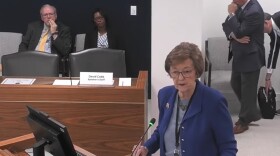The University of North Carolina Wilmington is facing a $4 million penalty for exceeding the UNC System’s out-of-state enrollment limit.
UNC-Wilmington has an 18% cap, but in the last two years 27% of its students have been from outside North Carolina. That amounts to an excess of 204 out-of-state students.

Five universities in the system have an 18% out-of-state student enrollment cap: Appalachian State University, North Carolina State University, The University of North Carolina at Chapel Hill, The University of North Carolina Charlotte and UNC-Wilmington.
The system’s remaining universities have caps ranging from 25% to 50%.
UNC System policy states that if a school goes over the enrollment cap two years in a row, the out-of-state students’ tuition must be taken out of the university’s budget.
“(This penalty) is essentially the 204 students above the cap times their non-resident tuition rate,” Chief Financial Officer Jennifer Haygood said.
UNC-Wilmington’s out-of-state tuition is about $20,000 per student. With the university’s 9% out-of-state student surplus, the penalty adds up to $4,102,644.
The UNC Board of Governors’ Budget and Finance committee voted to redirect that total to a need-based scholarship fund. The decision won’t be finalized until the full board votes on it on Thursday.
A new record
This is the largest enrollment cap penalty any UNC System school has been assessed, dating back to at least 2004.
UNC-Chapel Hill also exceeded its 18% enrollment cap this year. The university was not penalized, however, because it didn’t happen for two consecutive years.
In 2016, UNC-Chapel Hill was penalized $1 million for also going over an 18% enrollment cap two years in a row. The university exceeded the cap by 76 students, or by 1.5%.
This year, the committee voted to issue the school a warning, noting that it could be fined if it exceeds the cap in 2024.
Fall enrollment data
The UNC System also has another new record: first-time student enrollment.
Bethany Meighen, vice president for academic and student affairs, said this fall was the largest entering freshman class in the system’s history. It has increased by 6.6% or 2,384 students compared to last year.

Meighen said there was also an increase in overall enrollment. The system has about 3,000 more students compared to 2022, a total of 242,518.
Last year was the first time in nine years that the system’s enrollment decreased. While enrollment is up this year, it still hasn’t bounced back to 2021 levels.
“High school students are not choosing to go to college at the rates we first saw,” Meighen said, “but still, we saw a great rebound.”

When looking at the enrollment data per institution, 10 universities saw an increase in students and six had lower enrollment numbers compared to last year.
$500K return on investment
The Board of Governors also discussed a return on investment study looking into the UNC System’s 16 public universities.
The study found that North Carolinians with an undergraduate degree make a median of $500,000 more than those without one.
This comparison is even higher for graduate degrees, with students making a lifetime return on investment of $938,000.
The study was conducted by Deloitte and funded by the General Assembly. Deloitte researcher Peter Fritz said the data accounts for the value of student's earnings over time.
"The way to essentially interpret it is the instant you graduate from that (undergraduate) program, it's like I wrote you a check for $500,000,” Fritz said.
Undergraduate degree programs such as biotechnology, computer engineering and agricultural/extension education services had an even higher return on investment, generating a median ROI of over $1 million.

Overall, the study found that 93% of the UNC System’s programs have a positive return on investment for students.
In the future, the board plans to use this data to inform policy changes.
This could include creating action plans to improve low ROI programs, as well as updating their academic program review process to consider the value institutions and students receive.
Andrew Kelly, the UNC System’s senior vice president for strategy and policy, said the system’s current academic program productivity review has an “impoverished view of productivity.”
“It’s essentially a bean-counting exercise,” Kelly said. “We count the number of credentials produced by a program, not necessarily the value that either the institution or the students derive from those credentials. So this allows us an opportunity to refine and modernize that process.”
The board plans to spend the next six months assessing program performance. It plans to provide a follow-up report to the General Assembly by late April 2024.
This month’s Board of Governors meeting is taking place on UNC-Greensboro’s campus. UNC-G is currently conducting its own academic program review. This APR process has been met with protests from students and faculty who are concerned it might come with significant program cuts.







